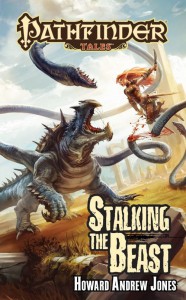Outlining
 I learned a while ago that no one method always seems to work for me when it comes to story drafting. I do have some tried and true tactics, but as I’ve told writing students, though the point is to scale the mountain and you’re likely to use the same tools each time, every mountain is a little different. You might use some of the tools less often, or not at all, or lean on some other device that you don’t usually employ.
I learned a while ago that no one method always seems to work for me when it comes to story drafting. I do have some tried and true tactics, but as I’ve told writing students, though the point is to scale the mountain and you’re likely to use the same tools each time, every mountain is a little different. You might use some of the tools less often, or not at all, or lean on some other device that you don’t usually employ.
These days I’ve been experimenting with super-detailed outlines. I found, though, in the writing of both The Bones of the Old Ones and Stalking the Beast that a super-detailed outline didn’t save me completely from having to rework things, hair loss, and general grumpiness. I’ve since hit on a second phase that really seems to be working for my new Hearthstones series. I don’t know if it will always work or if I will use it for every book going forward, but it’s working now, so I thought I’d share it.
First, I went ahead and drafted a super-detailed outline, which took weeks. It might have taken longer, but I had these characters and the world knocking around my head for a long time. Second, once I had the outline in hand, I started drafting it almost like a loose play — my “stagey outline.” It includes snatches of dialogue, bits of scenery description, and notes to myself about when some element or creature or piece of information was introduced. I didn’t just do this for a single chapter — I wrote to the end of the novel like this, which took another week or so. It varied in some places quite considerably from the super-detailed outline because I was moving through the story with the characters, and thus their needs and wants changed it organically. That’s always a plus.
 Now, as I write forward through the draft, the chapters are flowing pretty smoothly. It’s becoming one of those strong rough drafts that I used to hear about in envy. Maybe you’re one of those authors who can get the draft right after a polish or two. I’ve never been one of those writers (except with short stories) but I want to become one. I’m wondering if this is my method for making it happen.
Now, as I write forward through the draft, the chapters are flowing pretty smoothly. It’s becoming one of those strong rough drafts that I used to hear about in envy. Maybe you’re one of those authors who can get the draft right after a polish or two. I’ve never been one of those writers (except with short stories) but I want to become one. I’m wondering if this is my method for making it happen.
What’s working for me may or may not work for you — every writer’s experience is different. I think it’s working for me, though, because I’m playing to one of my strengths. Dialogue always comes fairly easily for me, and dialogue is the lynch pin of this method. If the dialogue isn’t sounding right as I’m doing the “stagey outline” then I just keep massaging it until it does, without having to worry about having wasted tons of effort on description I won’t need anymore, etc.
I should also say, though, that this method wouldn’t work if I didn’t know who my characters were. Because these characters are like a second skin to me (I’ve known most of then since before I knew Dabir and Asim) the conversations flow fairly easily.
Anyone else have any outlining strategies they feel like sharing?
3 Comments